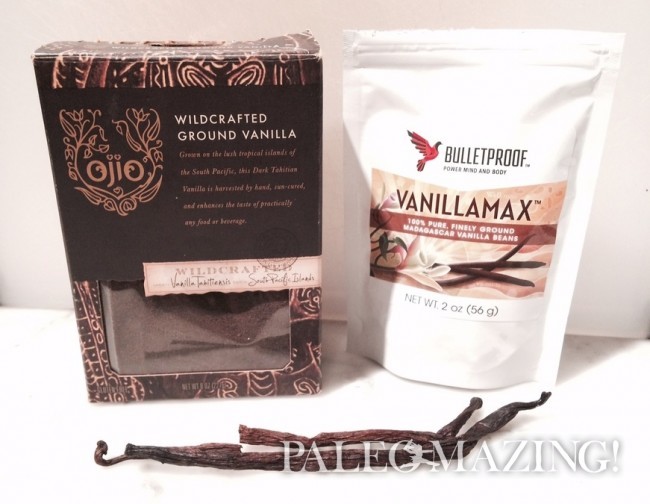I am sure the majority of us use vanilla these days. If you are in the kitchen at all I am sure you have extracts, pods or maybe even ground vanilla beans (powder). If not, I can safely assume you do drink some drinks or eat food with some type of vanilla as an ingredient. So, in essence the majority of us are ingesting it somehow. But are there hazards of toxins in these beans?
Could the source of these vanilla beans be causing anyone or myself gastric distress or inflammation? I was curious about this very topic as I for one use vanilla quite often and adore it and rely on it to get flavors I want into my paleo recipes. Vanilla bean harvesting is very similar to coffee bean harvesting and many of the sources are in the same or in close-by regions, so this seemed like a logical curiosity. There is ample evidence and plenty of discussion concerning molds and toxins as far as coffee beans are concerned.
I go out of my way to ensure I purchase organic vanilla beans, extracts and also vanilla powder (see above), yet is this enough? Could my own vanilla or my promotion of using vanilla of any kind in my recipes be causing another or myself any physical troubles or distress?
I am a frequent listener of Dave Asprey’s (BulletproofExec.com) podcasts and he regularly mentions his “pure” vanilla and how HIS is different, stating his is free of toxins and mold. My hunt began; I was not only on a quest for me but for you as well.
So, if you are curious about your own vanilla or supplier then I suggest you call or ask how they postharvest or prepare the vanilla beans. May be worth a call if you are experiencing symptoms in your quests for health, as who would have thought that vanilla could be a possible culprit? Not me! Do let me know if you have any questions for me about this subject by reaching out through my contact page.
I reached out to Dave to ask him what the heck makes his vanilla so darned special. Everything else he sells me I am thoroughly hooked on. Benjamin Prasser was kind enough to supply me with answers and references:
Hi Tina!
The postharvest preparation and processing of vanilla beans provides many opportunities for microbiological hazards to occur. This problem has become worse as demand for real vanilla increases, resulting in lower quality beans reaching the market. Things that influence the bulletproof process for vanilla are choosing beans high in vanillin which has natural antimicrobial activity against mold. We follow specific killing and drying steps to control mold on the beans, and focus on contamination and cross contamination between batches of beans. There are specific steps we take in conditioning and post process storage to eliminate or limit mold toxin formation. The final step that is unique to the bulletproof process is laboratory grade mold testing to verify that bulletproof process ™ worked, using our proprietary in-house standards for a broad range of mold toxins that are documented to occur with regularity in vanilla.
There is also a considerable problem of fraud and adulteration in real vanilla products because the demand for high-end vanilla exceeds the supply. Documented problems with vanilla include people adding compounds that are not actually vanilla to make low-quality vanilla appear to be higher quality. This includes adding artificial vanilla flavor, tonka bean extract, or even coumarin. There are more than 100 different vanilla species known, and we only eat three of them. Some suppliers mislabel the vanilla source species or geography to increase the price. – Benjamin Prasser for BulletproofExec.com Dave Asprey
Ref: “Vanilla” edited by Eric Odoux, Michel Grisoni, CRC Press 2011
Bachman, S., Pietka, M., and Zegota, H. 1995. Studies on some microbiological and chemical aspects of irradiated vanilla beans. Journal of Radioanalytical and Nuclear Chemistry 189 (1): 71-76
Blumenthal, C.Z. 2004. Production of toxic metabolites: Aspergillus niger, Aspergillus oryzae and Trichoderma reesei: Justification of mycotoxin testing in food grade enzyme preparation derived from the three fungi. Regulatory Toxicology and Pharmacology 39:214-228
Bourriquet, G. 1954. Alterations et defauts de vanilla prepare. In: G Bourriqeut ed. Le Vanillier et la vanilla dans le monde. Paul Lechevalier, Paris pp. 623-644
If you have any questions or suggestions, email me at Info (at) TinaTurbin (dot) com




This article was very interesting and sparked a question. This article, along with others I’ve read, hint that vanilla absolute can be toxic. Do you know if it’s because of the solvent left behind from processing or with such high purity/concentration does it contain coumarin? I haven’t been able to find an answer as to why it would be toxic or why a toxic substance would be used as an additive in perfumes (that would be absorbed through the skin) or foods (ingested). Would you have any further information as to why the absolute form of vanilla would be toxic?
Hi Tekla,
I do not have a complete answer to your question. I did visit a vanilla bean farm once and it was fascinating! I would stick with ethically sourced organic vanilla companies. Ones that test for molds, ensure purity, etc.